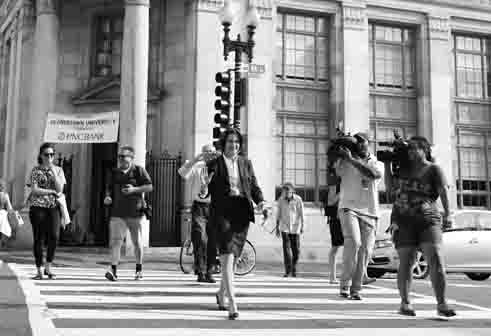Wisconsin and M Eyed for Safety Fixes

By Brady HoltCurrent Staff Writer
The intersection at the heart of Georgetown may get traffic-control officers next year to address its consistently high collision rates.
Ward 3 D.C. Council member Mary Cheh, who chairs the council’s transportation committee, said in an interview that pedestrians are at high risk at Wisconsin Avenue and M Street NW when motorists carelessly make turns.
“Any car-kind of aggressiveness — all of that can be better handled if you have traffic-control officers on the scene,” said Cheh. “We’ll have to find some money for that. I’m committed to looking for money to do that.”
Every year, the D.C. Department of Transportation compiles data on the District’s most dangerous intersections, combining accident severity, accident frequency and traffic volume statistics to rank them. Wisconsin and M is frequently near the top of the list — seventh in 2014, third in 2013 and first in 2012. The corner’s bustling traffic is compounded by narrow sidewalks.
Cheh hosted a site visit there earlier this month with participants from the Transportation Department, the community, and advocacy groups representing pedestrians and bicyclists, as part of her broader effort to address the most consistently troublesome intersections.
In addition to traffic-control officers, attendees at the site visit suggested various fixes including pedestrian bump-outs on the corners, longer times for pedestrians to cross M Street, a “block-the-box” ticket camera, a red light camera on M Street, having pedestrians cross Wisconsin farther south from the intersection, and relocating an inbound M Street bus stop closer to 31st Street, according to Cheh spokesperson Kelly Whittier.
Cheh said her office will “pester” Transportation Department officials weekly until the agency develops solutions for the troubled intersection. “It’s in their hands now to evaluate some of these suggestions and then to come back to us about what they can do, and what they can’t do and an explanation … and what might need legislation or a budget fix,” she said.
Transportation Department spokesperson Terry Owens wrote in an email yesterday that the agency is still reviewing options.
“We are still pulling together our observations from the site visits. Nothing to report yet,” he wrote. “Our goal is to publish a report once the evaluation process is complete that spells out our proposals.”
One improvement is already on the way, according to Ron Lewis, chair of the Georgetown advisory neighborhood commission: a new traffic signal that will allow right turns from southbound Wisconsin onto westbound M while M Street traffic is already turning left to head north on Wisconsin. The Transportation Department got that idea while looking at congestion on 34th Street NW, which Lewis said has already improved greatly thanks to some recent agency fixes.
Lewis, who attended Cheh’s site visit, said his own preferred solution would be using red-light cameras in addition to traffic-control officers, and that he’s hopeful that all this attention on Georgetown traffic will help the situation.
“It will certainly make a difference — I hope it’s a big difference,” Lewis said. “It’s an intersection with very significant pressures, so anything that we can do to relieve that would be valuable.”
Other frequently troublesome intersections in Northwest include Florida Avenue and 7th Street and several corners in the 14th Street NW corridor, according to the Transportation Department data.
This article appears in the Sept. 23 issue of The Georgetown Current newspaper.
